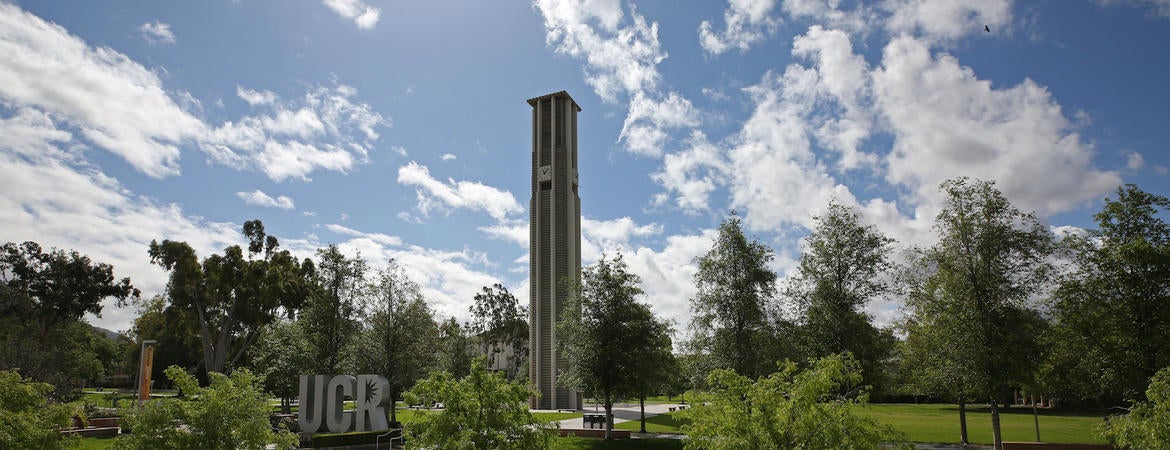
Since social distancing measures to prevent COVID-19 have emptied freeways, businesses and beaches, Southern Californians have been treated to dazzling blue skies and the fluffiest, whitest clouds imaginable.
The reason? Staying at home reduces emissions of nitrogen oxides, or NOx, which reduces air pollution. One UC Riverside air quality researcher thinks that’s both good news and bad news. To maintain our cleaner air and slow climate change by reducing pollutants, some of the shutdown’s lifestyle changes, such as teleworking, need to continue long after we’ve vanquished the pandemic.
Cesunica Ivey is an assistant professor of chemical and environmental engineering at UC Riverside. She has been studying how air pollution exposure varies over time for residents across inland Southern California. Her group uses both field and modeling approaches to answer questions related to high-risk microenvironmental exposure and environmental injustices. She is currently leading a collaborative study on the effects of meteorology and climate on ozone and fine particulate pollution in the South Coast Air Basin, which includes portions of Los Angeles, Riverside, and San Bernardino counties, and all of Orange County.
Ivey said NOx is useful for understanding air quality because it is directly emitted from the pollution source. There is thus a direct relationship between the pollutant source and its concentration in the atmosphere. Other pollutants form in the atmosphere through chemical reactions and require a few more steps to trace to the source.
Most NOx comes from cars and trucks and from stationary sources in urban areas such as power plants and factories. Because it is emitted by human routines, its levels are sensitive to changes in activities.
Air pollutant measurements are made at the ground level using stationary or mobile instruments, and in the lower atmosphere by instruments on manned or unmanned aircraft. Satellites that orbit Earth also monitor air pollutants. The California Air Resources Board’s Air Quality and Meteorological Information System, or AQMIS2, database offers readily accessible ground-based air pollutant measurements for hourly, daily, or annual air quality assessments.
When comparing hourly averaged nitrogen dioxide levels in Los Angeles and San Bernardino on weekdays in March 2020, hourly maximums decreased sharply the week following Governor Gavin Newsom’s March 19 stay-at-home order. The most significant changes occur in evening and nighttime nitrogen dioxide levels, which have decreased by more than 50% in some cases.
“Traffic-related pollution has been shown to be associated with short-term and long-term respiratory health impacts, so sensitive groups with high outdoor exposure will have a respite from vehicle pollution during this time,” Ivey said.
Los Angeles and San Bernardino show similar decreases, indicating less NOx throughout the entire basin. However, the news isn’t all good.
Daytime ozone levels are usually higher in the Inland Empire than in coastal regions, which is typical of the locations downwind of Los Angeles. Now, the reduction in evening NOx has brought higher levels of nighttime ozone, too.
Ozone makes air quality worse and can exacerbate respiratory conditions. Ozone is a gas that forms as pollutants from fossil fuel combustion, such as NOx, react with other molecules in the air.
In theory, less NOx should lead to less ozone. The real chemistry is far more complex. NOx can both produce and consume ozone. The chemical reactions that extinguish ozone occur mostly at night.
Without the Inland Empire’s fresh afternoon and evening rush hour emissions, these reactions are not clearing ozone from the air at the rate seen before the shutdown.
The shutdown has led to a more pronounced nighttime ozone effect in places like San Bernardino, which is already disproportionately burdened by local air pollution sources. While recent data available through AQMIS2 are preliminary, the most recent measurements point to an abrupt shift in atmospheric chemical processes in the South Coast Air Basin as a result of the shutdown.
“March 2020 ozone levels aren’t much different when considering the daily averages from 2017-2020,” Ivey said. “It’s the daily ozone swings that have changed, which is directly a result of the shutdown.”
Ivey’s own early findings indicate that improved emissions control technology in the last two decades along with warmer, drier days might be changing ozone behavior in Southern California. Ivey’s group is conducting analyses to determine whether the two phenomena have worked harmoniously or in opposition to affect ozone levels over past 20 years.
“I was most surprised to see a consistent global climate change signature in the local data we analyzed, including steadily increasing air temperatures and coastal sea surface temperatures,” Ivey said. “As an air pollution specialist, I am very aware of global heating, but seeing the same increasing trends in independent datasets, while expected, is ominous.”
Ivey thinks that recent improvements in air quality and the conversations in mainstream media have given the public first-hand evidence that when people act individually in large numbers, we see improvements in air quality, which means we can act together to slow climate change.
“Shifts in individual behavior can be incentivized by local, state, or federal policies, such as work-from-home tax credits,” Ivey said. “Businesses, universities, and other public organizations can allow employees to telework when it makes most sense and carry out meetings and business services via video conferencing whenever possible.”
Header photo: Blue sky and fluffy clouds over an empty UC Riverside campus on March 19, 2020. Stan Lim/UCR




